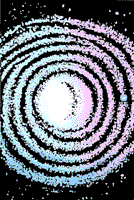
Dimdima
Online Children's Magazine from India

Dimdima
Online Children's Magazine from India

Until the invention of the telescope astronomers believed that the universe consisted of a few planets and the 6000 or so stars they could see with the naked eye.
When the telescope became available to them they were amazed to see that there were millions of stars in the heavens.
In 1785 the German-born English astronomer William Herschel came to the conclusion that our solar system was at the centre of a vast conglomeration of stars which were arranged in the shape of a lens. He estimated that the diameter of the universe was 7,500 light - years.
Over the next few centuries European and American astronomers worked doggedly to advance man's knowledge of the universe and by 1920 we knew this much : we were located not at the centre but at the edge of a disc - shaped galaxy. We had two star systems -- the Large Magellanic Cloud and the Small Magellanic Cloud -- as neighbours. This 'universe' was less than 20,000 light-years in diameter.
Scientists wondered if that was all there was to the universe.
In 1924 the American astronomer, Edwin Hubble found that there was much, much more to it. He discovered that we were not alone, that there were other galaxies besides our own.
In 1929 he made the astonishing suggestion that the galaxies were flying away from each other at tremendous speeds. The farther a galaxy, the faster it moved.
Today we know that some of the galaxies are flying away at speeds comparable to the speed of light!
So this is the picture we have of the universe now -- a universe that is perhaps hundreds of millions of light-years in diameter -- and expanding all the while.
EXPLORE MORE...
Get Help or Give Help.
- Do you have a Science Question?
- Post it here and get the answer.
- Some questions posted by others are not yet answered.
- View those questions and answer them.
Dimdima is the Sanskrit word for ‘drumbeat’. In olden days, victory in battle was heralded by the beat of drums or any important news to be conveyed to the people used to be accompanied with drumbeats.
Bharatiya Vidya Bhavan
K. M Munshi Marg,
Chowpatty, Mumbai - 400 007
email : editor@dimdima.com
Bharatiya Vidya Bhavan
505, Sane Guruji Marg,
Tardeo, Mumbai - 400 034
email : promo@dimdima.com
Dimdima.com, the Children's Website of Bharatiya Vidya Bhavan launched in 2000 and came out with a Printed version of Dimdima Magazine in 2004. At present the Printed Version have more than 35,000 subscribers from India and Abroad.